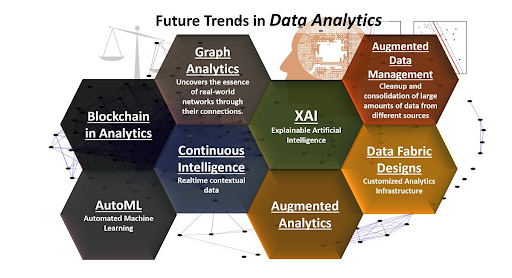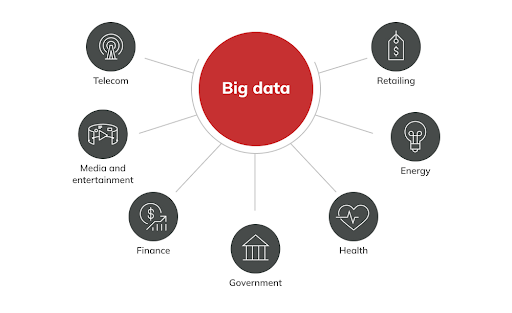Emerging Trends in Data Analytics in 2024: What to Expect
Introduction
Data analytics has become a cornerstone for modern businesses, providing the insights necessary to make informed decisions and stay competitive in today’s data-driven world. From understanding customer behavior to optimizing operations, the ability to analyze and interpret data is critical for success. This document provides an in-depth look at data analytics, including its importance, benefits, challenges, and overall impact on organizations.
Overview of Data Analytics
Data analytics refers to the process of examining large datasets to uncover hidden patterns, correlations, and trends. This process involves using specialized tools and platforms that can handle vast amounts of data, enabling businesses to derive meaningful insights. Data analytics encompasses various types, including descriptive, diagnostic, predictive, and prescriptive analytics, each serving different purposes in the decision-making process.
Importance of Data Analytics
The importance of data analytics cannot be overstated. It empowers organizations to:
Make Data-Driven Decisions: By analyzing historical and real-time data, businesses can make more accurate and timely decisions.
Enhance Customer Experience: Through customer data analytics, companies can better understand their customers' needs, leading to more personalized and effective marketing strategies.
Increase Operational Efficiency: Data analytics helps identify inefficiencies and areas for improvement, leading to streamlined operations and reduced costs.
Predict Future Trends: Predictive analytics allows businesses to anticipate market trends, customer behavior, and potential risks, enabling proactive strategies.
Data analytics continues to evolve rapidly, and as we move into 2024, several emerging trends are shaping the future of this field. These trends are driven by advancements in technology, the growing importance of data-driven decision-making, and the need for businesses to stay competitive in an increasingly data-centric world. In this blog, we’ll explore the most significant trends in data analytics for 2024 and their potential impact on organizations across industries.
1. AI-Driven Analytics
Artificial Intelligence (AI) is set to become even more integral to data analytics in 2024. AI-driven analytics tools are not only automating data processing but also enhancing the depth and accuracy of insights. Machine learning algorithms are being used to identify patterns in data that humans might miss, leading to more predictive and prescriptive analytics. These advancements enable businesses to anticipate market trends, customer behaviors, and operational challenges with greater precision.
Impact:
Businesses will increasingly rely on AI to make data-driven decisions quickly and accurately, allowing them to stay ahead of the competition and respond to changes in the market more effectively.
2. Edge Analytics
With the proliferation of Internet of Things (IoT) devices, edge analytics is gaining traction. This trend involves processing data at the edge of the network—close to the source of data generation—rather than relying on centralized data centers. In 2024, more organizations will adopt edge analytics to reduce latency, enhance real-time decision-making, and decrease the burden on central data systems.
Impact:
Edge analytics will be particularly valuable in industries like manufacturing, healthcare, and smart cities, where real-time data processing is critical for operational efficiency and safety.
3. Data Democratization
2024 will see a continued push toward data democratization, where data access and analytics capabilities are made available to non-technical users within an organization. This trend is driven by the development of user-friendly tools that allow employees at all levels to analyze data and gain insights without needing deep technical expertise.
Impact:
By empowering more employees to work with data, organizations can foster a data-driven culture, improve decision-making across all departments, and unlock innovation from within.
4. Augmented Analytics
Augmented analytics, which combines AI, machine learning, and natural language processing (NLP) to automate data preparation, insight discovery, and data sharing, is set to expand in 2024. This trend is helping to close the gap between data analysis and actionable insights, making it easier for organizations to derive value from their data.
Impact:
Augmented analytics will streamline the data analysis process, reducing the time from data collection to insight generation. This will enable businesses to act on data insights more quickly, driving better outcomes.
5. Data Privacy and Ethics
As data analytics becomes more pervasive, concerns about data privacy and ethics are growing. In 2024, expect to see more stringent regulations and a stronger emphasis on ethical data use. Organizations will need to navigate these challenges by implementing robust data governance frameworks and ensuring that their data practices are transparent and compliant with new regulations.
Impact:
Businesses that prioritize data privacy and ethics will build trust with customers and stakeholders, potentially gaining a competitive advantage in a market where data integrity is increasingly valued.
6. Data Fabric Architecture
Data fabric architecture is emerging as a key trend in 2024, offering a unified data management framework that integrates data across disparate systems and environments. This architecture enables seamless access, sharing, and management of data across the organization, regardless of where the data resides—on-premises, in the cloud, or at the edge.
Impact:
By adopting data fabric architecture, organizations can break down data silos, enhance data accessibility, and improve the overall efficiency of their data management processes.
7. Focus on Data Quality and Integration
As the volume of data continues to grow, the importance of data quality and integration is becoming more apparent. In 2024, organizations will increasingly focus on ensuring that their data is accurate, consistent, and reliable. This involves investing in tools and processes that can automate data cleansing, validation, and integration.
Impact:
High-quality, integrated data will lead to more accurate analytics, which in turn will drive better decision-making and outcomes for businesses.
8. Sustainability Analytics
Sustainability is no longer a buzzword; it's a critical business imperative. In 2024, sustainability analytics will become more prominent as organizations strive to measure and reduce their environmental impact. By analyzing data related to energy consumption, waste, emissions, and supply chain efficiency, businesses can identify areas for improvement and track their progress toward sustainability goals.
Impact:
Organizations that leverage sustainability analytics will be better positioned to meet regulatory requirements, enhance their brand reputation, and contribute positively to global sustainability efforts.
Pros of Data Analytics
Improved Decision-Making: Data-driven insights lead to better business strategies and outcomes.
Cost Efficiency: Identifying waste and optimizing resources can result in significant cost savings.
Competitive Advantage: Companies that effectively utilize data analytics can gain a significant edge over competitors.
Personalization: Data analytics allows for highly personalized customer experiences, driving satisfaction and loyalty.
Cons of Data Analytics
Data Privacy Concerns: Collecting and analyzing large amounts of data can raise significant privacy issues, especially if not managed correctly.
Complexity: Implementing and managing data analytics platforms requires specialized skills and can be complex and resource-intensive.
Cost: While data analytics can save money in the long run, the initial investment in tools, platforms, and talent can be high.
Data Quality: Poor data quality can lead to inaccurate insights, leading to misguided decisions.
Summary
Data analytics is an essential tool for modern businesses, offering invaluable insights that drive decision-making, improve efficiency, and enhance customer satisfaction. However, it comes with challenges such as data privacy concerns, complexity, and costs. Despite these challenges, the benefits of data analytics far outweigh the drawbacks, making it a crucial component of any business strategy.
Conclusion
In today’s competitive landscape, the ability to effectively harness data is a key differentiator for businesses. While data analytics presents certain challenges, its potential to transform how organizations operate and compete is immense. By carefully managing the risks and investing in the right tools and talent, businesses can unlock the full potential of their data, driving growth and innovation. The data analytics landscape in 2024 is set to be more dynamic and impactful than ever. As AI continues to enhance analytics capabilities, edge computing brings processing closer to data sources, and data democratization empowers more users, businesses will be able to harness data in new and innovative ways. However, with these advancements come challenges related to data privacy, ethics, and quality, which organizations must address to fully realize the potential of their data.
By staying abreast of these emerging trends and adopting the right strategies and technologies, businesses can transform their data into a powerful asset that drives growth, innovation, and sustainability in the years to come.
Thank You
Thank you for taking the time to explore the world of data analytics. We hope this guide has provided you with a comprehensive understanding of its importance, benefits, and challenges. As you continue to navigate the evolving landscape of data-driven decision-making, remember that the insights gained from data can be a powerful catalyst for success.
This structure covers all the key aspects of data analytics, offering a thorough and balanced perspective.
Thank you for exploring the emerging trends in data analytics for 2024 with us. Stay tuned for more insights as we continue to monitor and report on the latest developments in this ever-evolving field.
FAQ About Data Analytics
1. What is a data analytics platform?
A data analytics platform is an integrated suite of tools and technologies that enable organizations to collect, store, process, and analyze data. It provides the infrastructure and capabilities needed to handle large volumes of data from various sources, perform complex analyses, and generate insights that drive decision-making. Examples include platforms like Google Analytics, Tableau, and Microsoft Power BI.
2. How do data analytics tools differ from a data analytics platform?
Data analytics tools are specific software applications designed to perform particular data-related tasks, such as data visualization, data cleaning, or statistical analysis. In contrast, a data analytics platform is a comprehensive environment that encompasses a variety of these tools, offering a unified interface and workflow for the entire data analysis process—from data ingestion to reporting.
3. What is a data analytics solution?
A data analytics solution refers to a tailored set of tools, techniques, and processes implemented to address specific business challenges or goals through data analysis. This could involve anything from customer segmentation, predictive modeling, and fraud detection, to operational optimization. A solution is often designed to meet the unique needs of a business, leveraging a combination of platforms, tools, and custom-developed components.
4. Are there case studies available demonstrating data analytics solutions?
Yes, many organizations and technology providers publish case studies that illustrate how data analytics solutions have been applied to real-world business challenges. These case studies typically detail the problem, the approach taken, the technologies used, and the outcomes achieved, providing valuable insights for businesses looking to implement similar solutions.
5. How does AI play a role in data analytics?
Artificial Intelligence (AI) enhances data analytics by enabling more advanced and automated analysis techniques. AI can process large datasets rapidly, uncover patterns that might be missed by traditional methods, and provide predictive insights. Techniques like machine learning, natural language processing, and computer vision are often used within AI-driven data analytics to improve accuracy, efficiency, and the ability to handle unstructured data.
6. What is customer data analytics, and why is it important?
Customer data analytics involves the collection and analysis of data related to customer behavior, preferences, and interactions with a business. This type of analytics is crucial for understanding customer needs, personalizing marketing efforts, improving customer experience, and ultimately driving customer loyalty and business growth. By leveraging customer data, businesses can make informed decisions that enhance satisfaction and retention.









No comments:
Post a Comment